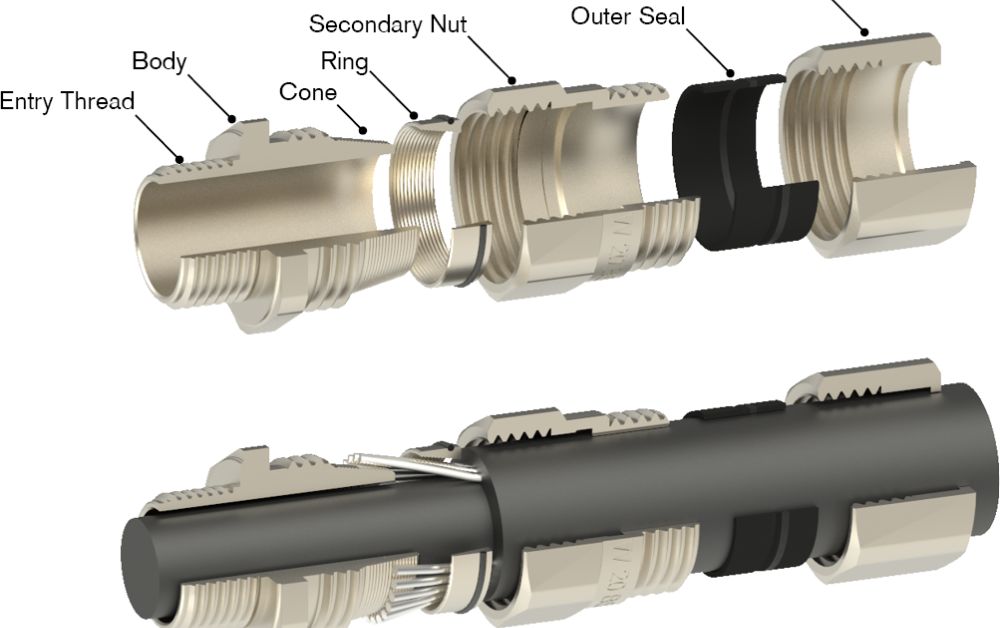In our modern world, electricity powers nearly every aspect of our lives. Behind the scenes, cable glands quietly play a crucial role in ensuring the safety, security, and reliability of our electrical connections. In this guide, we aim to simplify the complex world of cables glands, breaking down their significance, different types, how to choose the right one, installation tips, and their pivotal role in enhancing safety and efficiency.
Understanding Cables Glands
Cable glands may seem like small and unassuming components, but they are indispensable. These devices are designed to attach and secure electrical cables to equipment. They provide strain relief, seal the cables entering electrical equipment, and maintain the enclosure’s protection level. Simply put, cable glands ensure that our electrical connections remain secure and safe.
Exploring the Types of Cables Glands
Types Based on Usage Environments
Cable glands come in various types, each tailored to specific environments and applications. Some are designed for indoor use, offering basic protection and strain relief. Others cater to outdoor or hazardous locations, providing advanced features like waterproofing and explosion-proof capabilities.
The Significance of Material
The material from which a cable gland is constructed is crucial. Common materials include plastic, brass, stainless steel, and aluminum. Each material offers different levels of durability, corrosion resistance, and electrical conductivity.
Armoured vs. Unarmoured
Cable glands are categorized based on the type of cable they are meant to secure. Armoured cable glands are designed for cables with an additional protective layer, providing grounding or earthing capabilities. Unarmoured cable glands focus primarily on sealing and strain relief and are used with standard cables.
Selecting the Right Cables Gland
Choosing the appropriate cable gland involves considering several critical factors:
Understanding the Application
Begin by identifying the cable type and the environment in which it will be used. Consider factors such as exposure to water, extreme temperatures, and potentially explosive atmospheres.
Size and Compatibility
Ensure that the chosen cable gland aligns with the cable’s diameter and is compatible with the equipment to which it will be attached. Incorrect sizing can result in inadequate sealing and strain relief.
Compliance and Standards
Opt for cable glands that comply with relevant industry standards and certifications, guaranteeing that they meet the safety and quality requirements specific to your application.

Installation Tips for Success
Proper installation of cable glands is as essential as selecting the right one. Here are some invaluable tips to ensure a successful installation process:
Read the Instructions
Always commence by thoroughly reading the manufacturer’s instructions. Each cable gland may have specific installation requirements crucial to maintaining its effectiveness.
Utilize the Correct Tools
Employ the appropriate tools for tightening and securing the cable gland. This prevents damage to both the gland and the cable, ensuring a secure and reliable fit.
Seal Validation
During installation, verify that all seals are correctly positioned and intact. This step is particularly vital in environments where waterproofing is of paramount importance.
Regular Inspection
Post-installation, incorporate a regimen of regular inspections. This proactive approach aids in early issue detection, averting potential failures or safety hazards.
Cables Glands: Champions of Safety and Efficiency
Cable glands play a pivotal role in enhancing the safety and efficiency of electrical installations. By securely fastening cables, they prevent accidental disconnections, mitigate the risk of electrical shorts, and prolong the equipment’s lifespan. In hazardous environments, their significance escalates, as they act as barriers, inhibiting the ingress of flammable gases or dust into electrical equipment, thereby reducing the likelihood of explosions or fires.
Also Read – A Simple Guide to Understanding Cables Glands
Conclusion
Although cable glands may seem insignificant in the vast landscape of electrical installations, their role is nothing short of indispensable. They ensure that electrical connections are not only secure but also resilient against external factors that could compromise the integrity of the entire system. Whether you’re embarking on a simple home project or overseeing complex industrial installations, grasping the fundamentals of cable glands, from comprehending their types and materials to mastering the selection and installation procedures, is indispensable. Armed with this knowledge, you can rest assured that every electrical connection within your project is not only secure and reliable but also upholding the highest safety standards. Remember, the right cable gland not only protects your electrical installations but also significantly contributes to the safety and efficiency of your entire operation.
This article is publish by usidesk.co.uk should have given certain idea about cables glands .

